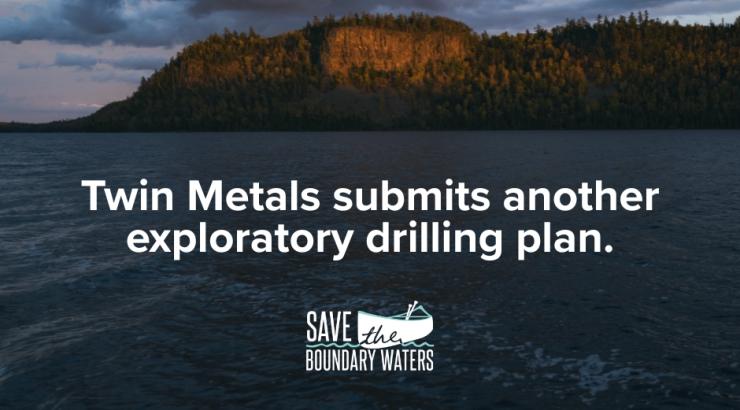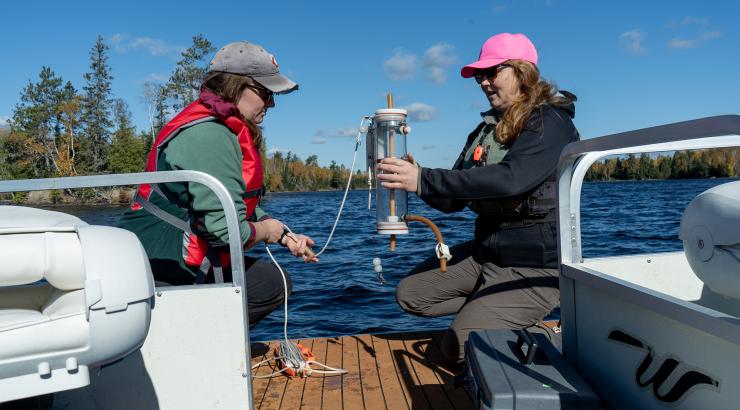“Critical Minerals” Offers Poor Justification for the Twin Metals Mine.
Over the past several years, mining interests and President Trump’s Administration have misused the concept of “critical minerals” as a scare tactic partly to justify the rolling-back of clean water protections and the gutting of longstanding environmental review rules. See, e.g., Sections 3 (a, b, and d) and 4 (b) in the Dec. 20, 2017 Executive Order 13817 “A Federal Strategy to Ensure Secure and Reliable Supplies of Critical Minerals,” instructing federal agencies to create a list of minerals of critical importance to the economic and national security of the United States. The Administration’s argument can be refined to something like this: 1) the U.S. relies on imports to obtain supplies of key minerals; 2) import reliance leaves the U.S. vulnerable to having its mineral supplies cut off; 3) mining more at home will free us from our reliance.
Yet upon inspection there are serious flaws in how the industry and Administration use the concept of critical minerals. The most-promoted solution by the mining industry and its mouthpieces -- more mines (in more sensitive places) -- has been grossly oversold. In addition, the Administration’s actions to advance one such mine -- the Chilean-owned Twin Metals Mine proposal in northeastern Minnesota -- undercut the Administration’s own critical minerals case for the mine. These flaws and inconsistencies are explained below.
1. Import reliance does not equal import vulnerability.
In its June 4, 2019 “Strategy to Ensure Secure and Reliable Supplies of Critical Minerals, the Department of the Interior correctly notes that the U.S. imports 100% of certain minerals it has classed as critical. Interior errs, however, in defining import reliance as a problem and a vulnerability. For example, Canada is a leading supplier of critical minerals to the United States. This puts U.S. national security at risk only if we expect imminent hostilities from our northern neighbor. The U.S. imports other minerals on the list from Mexico, Belgium, India, Germany, South Africa, the United Kingdom, Australia, Austria, Estonia, Japan, South Korea, Malaysia, and Rwanda. In short, the U.S. can and does source important minerals from a host of trading partners - many of them long-time allies. Our allies and trading partner options are a source of strength and security.
2. For many of the listed critical minerals, the industry imports because the metals are produced more cheaply overseas.
Many of the 35 identified critical minerals are not mined alone, but are produced in significant quantities in the as byproducts of hardrock gold, copper, and lead mining operations. Call them “byproduct critical minerals,” or simply “byproducts.” The U.S. has no shortage of gold, copper, and lead-producing mines, and these mines produce metal concentrates that must be processed in a smelter and then further refined to produce pure streams of distinct metals.
The U.S. Geological Survey explains that, “the recovery of these byproducts typically is low compared to the total amount of material that was made available from mining, and recovery facility capacity poses a greater restriction on supply than geologic availability.” The copper, gold, and lead concentrates shipped to smelters contain lots of critical minerals such as arsenic, antimony, bismuth, cobalt, tellurium, and others, but the smelters discard these byproduct minerals as impurities and waste products. The smelters do not invest to fully recover these “byproduct critical minerals,” simply because it would cost more to produce them than the smelter/refiner could make in selling them. In short, a new mine [the Twin Metals Mine] won’t solve this problem, and therefore this set of critical minerals should not be used by the Administration as an excuse for promoting risky mines in sensitive places, or for gutting environmental laws. Rather, a production credit (if that’s desired) or a run-of-the-mill supply crunch would cause prices to rise, and the market to respond accordingly.
That’s exactly what happened in the rare case of an actual constraint on trade in rare earth elements. In 2010 when China attempted to corner the market for the rare earth elements by restricting exports, the market reacted by raising rare earth element prices (the WTO also intervened, but the metals market achieved results more promptly). As a result, additional mines, some of which had been on long-term “care and maintenance” since the cheaper producers in China had undercut their prices years earlier, came back into production. The Mountain Pass rare earth elements mine in California is the prime example.
In addition, if the real concern short-term interruptions such as might occur between the start of a restriction on trade and a resumption in supply from either domestic producers or replacement trade from allied countries, the U.S. has in the past and could in the future rely on domestic strategic stockpiles of select minerals. Particularly when overseas mines are lower-cost suppliers than domestic sources of potentially critical minerals, it makes sense for the federal government (Dept. of Defense, Dept. of Commerce, or U.S. Geological Survey) to make steady additions to our domestically-based strategic stockpiles.
3. Even if it were ever built, the TMM mine would meet less than 4% of the U.S. annual demand for cobalt, (assuming perfect recovery), and as U.S. consumption rises, that percentage would decline; the U.S. could sacrifice water and air quality in the Boundary Waters, and still need to import > 96% of its cobalt needs.
The Trump Administration has promoted the Twin Metals Minnesota copper-nickel mine (TMM) as a way to “reduce the vulnerability to disruption of critical mineral supplies,” even though copper and nickel are not critical minerals. The minerals at issue are the very small amounts of platinum, palladium, and cobalt that could be produced by a TMM mine.
It is not wise to get hung-up on platinum and palladium from a mine that might come into production 14 years from now. Both palladium and platinum are heavily used in the manufacture of catalytic converters, which are not found on electric vehicles. Gasoline vehicles are expected to be in steep decline 2035, which is likely the earliest a TMM mine might possibly come online. The advent of price parity between electric and gasoline cars, after all, is expected by 2025, if not sooner, which means long-term demand (and prices) for Pt and Pd will likely decline. That leaves cobalt to consider.
Proponents of the TMM like to talk about cobalt, of which the U.S. has almost no domestic sources. But TMM will produce very small quantities of cobalt, as a byproduct mainly from the smelting/refining of its nickel concentrates. Cobalt is not present in sufficient quantities at TMM to make much of a dent in the U.S.’s growing appetite for the metal. For example, the U.S. apparent annual consumption of cobalt in 2019 was 12,400 metric tons. In comparison, TMM’s average cobalt production over 25 years might be -- assuming 100% recovery of the metal, which is never achieved -- as much as 460 metric tons per year, meaning that at some point, many years from now, TMM could supply only 3.7% of the U.S. yearly consumption in 2019.
Thus, under the TMM proponents’ plan, the U.S. would risk the permanent pollution of the Boundary Waters and still be reliant upon imports and other mines for 96.3% of its cobalt consumption. Who but the mining company and its Chilean billionaire owners could possibly think of this as a good bargain?
Moreover, the focus even on that tiny supply of cobalt presumes that it would be mined, smelted, and refined and made available in the U.S., which turns out is a false assumption.
4. Critical minerals from the Twin Metals mine would go to China, not the U.S.
Critical minerals from a TMM mine would be sent overseas, most likely to China.[2] This is true for two reasons. First, the U.S. already produces more copper and nickel concentrates than it has capacity to smelt. Thus, the TMM mine, or indeed any new copper-nickel mine, would be sent for smelting overseas.
The result of initial mining extraction is a mineral concentrate that needs to be smelted and refined in order to produce pure stocks of copper, nickel, and other metals from which manufactures create end products. There are only three active copper smelters located and still operating in the U.S., and these are vertically-integrated, meaning that the companies that own them also own their own copper mines, which supply the smelters with enough concentrates to keep them running at or near capacity. In addition, there are zero (0!) nickel smelters in the U.S. Accordingly, any new copper-nickel mine (such as TMM) will certainly send its copper and nickel concentrates out of the country for smelting, most likely to China, Japan or South Korea. Since it is owned by Antofagasta PLC, a TMM mine would likely send its concentrates to China for smelting/refining, as Antofagasta does.
In short, a TMM mine would not make America great. It would produce very little critical minerals, and it would send American critical minerals to China or other overseas countries with ample and cheap smelting capacity.
The second reason why any critical minerals from a TMM mine could be shipped overseas to fuel China’s economy is a Trump Administration decision in 2019. The old version of the federal mineral leases held by TMM contained a provision requiring the leaseholder, if it shipped concentrates overseas for smelting, to return an equivalent amount of refined metal to the U.S. In 2019, however, the Department of the Interior removed that provision when it renewed the leases. By removing that key provision from TMM’s federal mineral leases, the Trump Administration aided the movement of critical minerals out of the United States.
If "critical minerals" were anything more than a fig-leaf for the Administration’s determination to gut environmental protections, gut NEPA, and force risky mines into some of the most sensitive and beloved public lands in America, then the Trump Administration would have kept in place the “return to U.S.” provision in the federal mineral leases. Now, however, Antofagasta PLC has neither the obligation nor the incentive to bring the refined metals back.
To summarize, “critical minerals” as a concept is a poor justification for the TMM mine:
-
the U.S. has many trading partners, including long-time allies, with whom we trade for critical minerals. Those trading networks are a source of U.S. strength.
-
Many of the minerals that are identified as critical minerals are in fact produced in sufficient supply in copper, nickel, lead, and gold concentrates, but are discarded as waste material and not recovered during smelting/refining because the costs of recovery exceed the sale price at current prices; hence the issue is one of lower-cost producers overseas, as opposed to domestic lack of supply from existing mines.
-
Even in the case of cobalt, the best example of a critical mineral that the TMM mine can offer, pushing the TMM mine would meet less than 4% of domestic demand, and dropping.
-
And the TMM mine, if it were ever built, would supply China with critical minerals, not the U.S., because the U.S. has no nickel smelters, its three copper smelters are all fully-subscribed, and furthermore because the Trump Administration changed the terms of the federal mineral leases needed by TMM, so that TMM no longer has to bring back to the U.S. any of the metals it sends overseas for processing.



